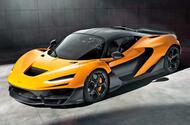The tech secrets behind McLaren’s new 915bhp V8


Woking-based brand’s new V8 takes on a familiar engineering catch-22
McLaren’s new 3988cc, twin-turbo, MHP-8 V8 powering the W1 supercar is the most power-dense combustion engine the company has yet produced, at 230bhp per litre, and also the highest revving at 9200rpm.
The V8 is once more manufactured in Worthing by Ricardo, which has built 38,000 engines for McLaren Automotive since 2011, starting with the M838T for the MP4-12C.
The design reveals some traditional details. An example is the valvetrain, one of the most highly stressed areas of any engine and where engine designers can find themselves in a catch-22. Introducing a feature to cope with one extreme can cause other problems.
One such demon is valve bounce, where the inlet and exhaust valves are moving so fast they literally bounce on their seats when closing, causing damage or failure.
The classic way of solving this is to use more powerful double valve springs, but that means more force is needed to open the valves, increasing the load on the valvetrain even more.
In the MHP-8, lightweight, hollow intake valves allow the use of single valve springs, reducing loads on the system, and hollow exhaust valves (which get hotter) follow tradition by using sodium filling to draw heat away from the heads.
A more recent technology frequently used is Diamond-Like-Coating (DLC) of the finger followers, which act on the cams to open the valves. DLC reduces friction between surfaces and that too reduces valvetrain loads.
The cylinder bores of the aluminium alloy block are plasma spray coated. Pistons can’t slide in alloy bores, the material is too soft, and the traditional approach was to insert cast iron liners. Plasma spray coating is the latest method for replacing that, reducing weight and friction.
Dry sump lubrication includes an electronically controlled variable displacement oil pump that should minimise the power consumed in pumping oil, with a four-stage pump to scavenge the dry sump.
On the intake side, the engine is fed using both direct and port fuel injection. This is not uncommon and every manufacturer has it own strategy for when each is used to get the best of both worlds.
Typically DI is used at high rpm to optimise fuel and air mixing and also cool the air inside the cylinder, with PI being used at low rpm to encourage stable combustion.
Twin-scroll turbos, one for each bank of cylinders, separate exhaust pulses for fast response. The net result of all this attention to detail is an engine that produces 915bhp.
Combined with the hybrid e-module mounted on the transmission, that rises to 1258bhp, backed by 988lb ft from 2500rpm. Mighty indeed.
Source: Autocar RSS Feed
Recent Posts
Linda Cardellini Will Be Jason’s Murderous Mom in the Friday the 13th TV Show
She's the first big name to board the long-delayed slasher prequel show Crystal Lake.
watchOS 11.4 gives your Apple Watch an alarm feature it’s long been missing
The next Apple Watch software update is on its way. watchOS 11.4 just debuted its…
Webb Spots ‘Cosmic Tornado’ in Stunning Detail
The Webb Space Telescope captured a chance alignment of a protostellar outflow and a spiral…
Duckett says England losses in ODI and Champions Trophy ‘hurt me so much’
Opener insists results matter despite comments in IndiaDuckett clarifies social media posts on Jasprit BumrahBen…
MagSafe Monday: In a sea of lookalike batteries, SHARGE stands out with a see-through design
If you’ve ever looked, you’ll notice that most MagSafe batteries look the same. The same…